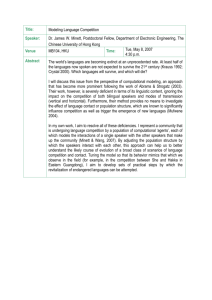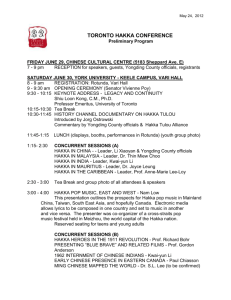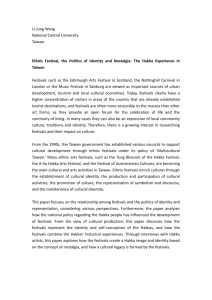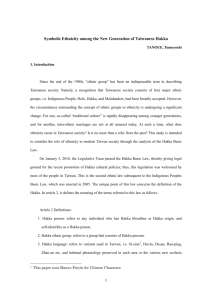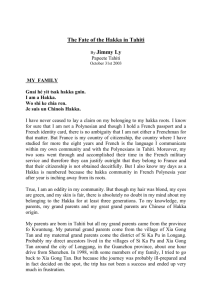Symbolic Ethnicity among the Taiwanese Hakka: An Analysis of the
advertisement
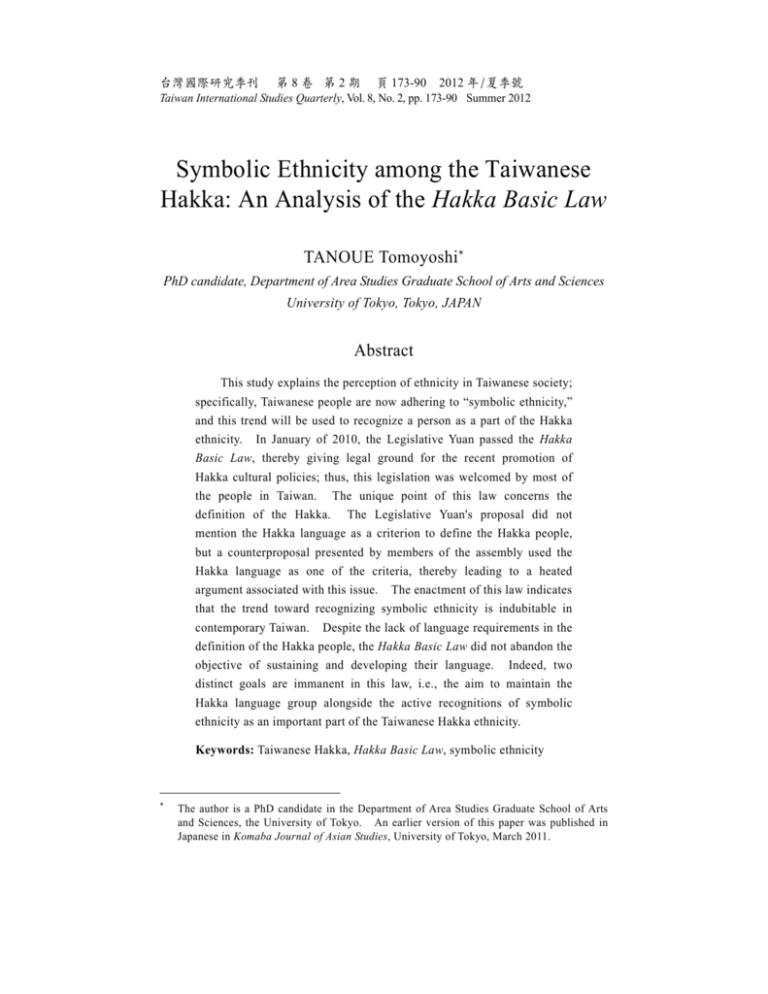
台灣國際研究季刊 第 8 卷 第 2 期
頁 173-90
2012 年/夏季號
Taiwan International Studies Quarterly, Vol. 8, No. 2, pp. 173-90 Summer 2012
Symbolic Ethnicity among the Taiwanese
Hakka: An Analysis of the Hakka Basic Law
TANOUE Tomoyoshi∗
PhD candidate, Department of Area Studies Graduate School of Arts and Sciences
University of Tokyo, Tokyo, JAPAN
Abstract
This study explains the perception of ethnicity in Taiwanese society;
specifically, Taiwanese people are now adhering to “symbolic ethnicity,”
and this trend will be used to recognize a person as a part of the Hakka
ethnicity. In January of 2010, the Legislative Yuan passed the Hakka
Basic Law, thereby giving legal ground for the recent promotion of
Hakka cultural policies; thus, this legislation was welcomed by most of
the people in Taiwan. The unique point of this law concerns the
definition of the Hakka. The Legislative Yuan's proposal did not
mention the Hakka language as a criterion to define the Hakka people,
but a counterproposal presented by members of the assembly used the
Hakka language as one of the criteria, thereby leading to a heated
argument associated with this issue. The enactment of this law indicates
that the trend toward recognizing symbolic ethnicity is indubitable in
contemporary Taiwan. Despite the lack of language requirements in the
definition of the Hakka people, the Hakka Basic Law did not abandon the
objective of sustaining and developing their language. Indeed, two
distinct goals are immanent in this law, i.e., the aim to maintain the
Hakka language group alongside the active recognitions of symbolic
ethnicity as an important part of the Taiwanese Hakka ethnicity.
Keywords: Taiwanese Hakka, Hakka Basic Law, symbolic ethnicity
∗
The author is a PhD candidate in the Department of Area Studies Graduate School of Arts
and Sciences, the University of Tokyo. An earlier version of this paper was published in
Japanese in Komaba Journal of Asian Studies, University of Tokyo, March 2011.
174 《台灣國際研究季刊》第 8 卷、第 2 期(2012/夏季號)
1. Introduction
The term “ethnic group” has been indispensable when describing
Taiwanese society since the end of the 1980s. Specifically, a recognition of the
fact that Taiwanese society consists of four major ethnic groups—Indigenous
people, Holo, Hakka, and Mainlanders had been broadly accepted. But the
circumstances surrounding the concept of ethnic groups or ethnicity are
undergoing a significant change. For one, so-called “traditional culture” is
rapidly disappearing among the younger generations, and secondly, inter-ethnic
marriages are now not at all unusual. Under such circumstances, what does
ethnicity mean in Taiwanese society? How do the Taiwanese consider the
concept of “ethnicity” or “ethnic group” in contemporary Taiwan? What
changes have occurred pertaining to the concept of ethnicity? Hakka Basic Law,
which was enacted in 2010, defines who Hakka people are, and it includes
unique criteria for Hakka. We can see the substantial change of recognition
toward the property of ethnicity. This study is intended to examine the
transition of the concept of ethnicity in modern Taiwanese society through
analysis of the Hakka Basic Law.
Indigenous people are recognized as a minority group in Taiwan because
of their social and economic disadvantages, as well as their cultural
disadvantages. In contrast, Hakka people, who make up 13.6% of the total
population in Taiwan, are part of the Han Chinese, the majority.1 Still, the
culture of Hakka people, especially their language, had been excluded from
public space until recently. Furthermore, Hakka language population is much
1
In this article, the data of Hakka population are based on the result of “Survey of Nationwide
Hakka Population’s Basic Data” by Council for Hakka Affairs in 2010. However, it has
adopted slight different categories from “four major ethnic groups.” According to this
survey, those who identify themselves as Holo constitute 67.5% of the total Taiwan
population, Mainlanders constitute 7.6%, Mainlanders’ Hakka constitute 0.5%, Indigenous
People constitute 1.8%, Taiwanese constitute 7.5%, and others make up 0.5%. There is not
a precise data about the population of “four major ethnic groups” except Indigenous People
those who need to register their identity to receive some preferential treatments. Huang
(1993) estimates the population of “four major ethnic groups”: Holo=73.3%, Hakka=12%,
Mainlander=13%, Indigenous People=1.7%. Recently, with the rapid increase the number
of international marriage immigrants and foreign guest workers from 1990s, some scholars
began to call them “the fifth ethnic group.”
Symbolic Ethnicity among the Taiwanese Hakka: An Analysis of the Hakka Basic Law 175
smaller than that of Holo, and it is not be used outside of the Hakka people’s
traditional settlements, which means their language is now facing possible
extinction. Because of their disappearing language, they are recognized as a
minority group.
On January 5, 2010, the Legislative Yuan passed the Hakka Basic Law,
thereby giving legal ground for the promotion of Hakka cultural policies. This
legislation was welcomed by most of the people in Taiwan. The Hakka Basic
Law is the second ethnic enacted behind the Indigenous People's Basic Law,
which was passed in 2005. Zhong (2010) analyzed the contents of the law from
the legal perspective, but few studies have addressed the sociological meaning
of the enactment of it so far. The Hakka Basic Law indicates that the concept
of ethnicity is in the process of changing. One of the most unique points of this
law is that, in Article 2, it actually defines phrases associated with Hakka.
(1) Hakka person: refers to any individual who has Hakka bloodline or
Hakka origin, and self-identifies as a Hakka person.
(2) Hakka ethnic group: refers to a group that consists of Hakka persons.
(3) Hakka language: refers to variants used in Taiwan, i.e. Si-xian,2 Hai-lu,
Da-pu, Rao-ping, Zhao-an, etc., and habitual phraseology preserved in
each area or the various new ecolects which emerged because of
adding modern vocabulary.
(4) Hakka population: refers to statistical results of population research
conducted by the Council for Hakka Affairs, Executive Yuan.
(5) Hakka Affairs: refers to public affairs concerned with the Hakka ethnic
group.
Ordinarily, we would consider the ability to speak the Hakka language the
most important criterion in determining whether an individual is Hakka or not.
Although architecture, cuisine, clothing, or religious beliefs are also presented
as parts of Hakka culture, it is almost impossible to show common cultural
characteristics shared among people who are called Hakka. However, this law
does not consider language a criterion for Hakka ethnicity because an
increasing number of young Hakka people cannot fluently speak or even
2
This paper uses Hanyu Pinyin for Chinese characters.
176 《台灣國際研究季刊》第 8 卷、第 2 期(2012/夏季號)
understand the language at all. Under such a circumstance, it is difficult to
consider the language an identifier for Hakka people. Taiwanese people are
now adhering to “symbolic ethnicity,” and this trend will be used to recognize it
as an important part of the Hakka ethnicity.
“Symbolic ethnicity” is a concept used to refer to the ethnicity of the
descendants of European immigrants in the United States. In the early
twentieth century, the expectation was widely accepted that the immigrants
from various countries would be assimilated into American society, which was
represented by the metaphor “the melting pot”; hence, that ethnicity would
gradually lose its role in the modern American society. M. Hansen, in contrast
to the straight-line assimilation theory, focused on the intergenerational
differences of ethnicity. Hansen stated that compared to the second generation
(the sons and daughters of immigrants), who wanted to forget and lose as much
of the evidence of their foreign origin as they could, the attitudes of the third
generation toward the culture of the immigrant generation was wildly different.
They were American-born, and their speech was the same as those with whom
they associated. Thus, the third generation had no reason to feel any inferiority.
H. Gans argued the role of ethnicity in the third and fourth generation,
expressing that a new kind of ethnic involvement might be stirring among them.
Gans coined the term “symbolic ethnicity” to indicate the ethnicity of white
Americans whose ethnic characteristics had disappeared.
In his view,
symbolic ethnicity is characterized by a nostalgic allegiance to the culture of
the immigrant generation, or that of the old country: a love for and a pride in a
tradition that can be felt without having to be incorporated in everyday behavior
(Gans 1979). According to R. Alba, because of widespread social mobility
and intermarriage, ethnicity has become increasingly peripheral to the lives of
many Americans of recent ethnic origins. But they do not relinquish ethnic
identity entirely; rather, they adapt it to their current circumstances, selecting
from their ethnic heritage a few symbolic elements.
This symbolic
identification with the ethnic group allows individuals to construct personal
identities that contain some ethnic “spice.” But at the same time, it represents
a personalization of ethnicity that frequently amounts to little more than a token
acknowledgement of ethnic background (Alba 1990, 29-30).
Symbolic Ethnicity among the Taiwanese Hakka: An Analysis of the Hakka Basic Law 177
2. The Hakka movement and Hakka cultural policy
The purpose of the Hakka Basic Law is to give legal ground for the recent
promotion of Hakka cultural policies. In this section, let us glance at the history
of the Hakka ethnic movement and Hakka cultural policies that began to be
implemented subsequent to the Hakka movement from the end of the 1980s to
the present.
Since the early 1980s, the environment for civil society and
NGOs has changed dramatically in Taiwan, allowing for many and autonomous
NGOs to become established entirely on the basis of local initiative and
resources.
The social movement NGOs established in this period facilitated
and fostered Taiwan’s democratic transition and transformed the power
relationship between the state and civil society (Hsiao 2006, 226).
In
particular, the abolishment of martial law in 1987, which remained in force for
thirty-eight years, gave crucial momentum for the civil society in Taiwan to
increase the number of collective actions to solve social problems.
Social
movements in this period spanned a wide range of issues, including the
environment, Indigenous people, gender, laborers, and peasants.
group began to make their own claims of authority.
Then each
The Hakka movement,
which began at the end of the 1980s, as did the aboriginal movement, was
focused on the ethnic problem.
The main issue of the Hakka movement was the language problem.
After
the Kuomindang (KMT, literally the Chinese Nationalist Party) took over
Taiwan as a result of the surrender of Japan in World War II, KMT established
Mandarin as the national language, and started to implement a “national
language policy” to diffuse it.
Taiwanese mother tongues (Holo, Hakka, and
the Indigenous languages) had low status under the “national language policy”
under KMT rule until the 1980s.
These languages had been positioned as
“dialects,” and speaking them was strictly prohibited in schools and in the
media.
As the result of the “national language policy,” Mandarin spread over
Taiwan as “the national language”; consequently, Taiwanese mother tongues
had become more and more difficult to pass on to the younger generation.
178 《台灣國際研究季刊》第 8 卷、第 2 期(2012/夏季號)
The beginning of the Hakka Movement goes back to the publication of a
magazine Hakka Storm (Kejia fengyun) in 1987. The Hakka people who
published it also established the Association for Promoting Hakka Interest
(Kejia quanyi cujinhui). The Association held a massive demonstration at the
end of 1988 in which six to seven thousand people from all over Taiwan
participated. In this demonstration, they employed the slogan “Reclaim Mother
Tongue for Me,” and demanded open TV programs in the Hakka language,
revision of article 20 of the Broadcasting and Television Act from a restrictive
clause to a guarantee clause about dialect usage, and establishment of a
pluralistic and open language policy (Hakka Storm 1989, 15, 57).
Responding to the Hakka ethnic movement, the government started to pay
attention to the Hakka culture, and began gradually implementing policies
intended to protect and develop it. At the central level, the Council for Hakka
Affairs, Executive Yuan was founded in June 2001, and organizations that dealt
with Hakka affairs were formed in several local governments.
The
Democratic Progressive Party (DPP) government, which took power by the
presidential election in 2000, had a great deal of interest in ethnic policies, and
so built active policies pertaining to ethnic culture.
Hakka cultural policy, which has been carried out in recent years, is
concerned with preservation of the Hakka language, encouragement of
academic research about Hakka, and promotion of Hakka culture. The most
specific issue insisted upon in the “Reclaim Mother Tongue for Me”
demonstration was the linguistic right to allow them to use and listen to their
mother tongue in the mass media. After that demonstration, several TV
channels began to make programs in which Hakka language was spoken to
some degree, and the Hakka TV channel was established in July 2003,
broadcasting TV programs mainly in the Hakka language. As for the language
education, some local governments controlled by the DPP started to teach
Taiwanese mother tongues in elementary schools around 1990. Subsequently,
these languages were adopted into the official curriculum by the central
government. Currently, the Hakka language is taught in every elementary
school in Taiwan and in some junior high schools. The Hakka Research
Center was established in 1999, and the College of Hakka Studies was
Symbolic Ethnicity among the Taiwanese Hakka: An Analysis of the Hakka Basic Law 179
established in 2003 at National Central University. These were the first
research and educational organizations pertaining to “Hakkaology” in Taiwan.
Recently, research centers and graduate schools focusing on Hakkaology have
been established in universities all over Taiwan. Several Hakka cultural parks
have also been built, and Hakka cultural festivals are being held every year in
all over the country as the Council for Hakka Affairs selected sixteen major
festivals held in Hakka villages to promote traditional Hakka culture.
Despite policies meant to improve the environment of the Hakka language,
the actually situation of the language has not much improved. The latest
survey released by the Council for Hakka Affairs showed that 62.8% of Hakka
people have the listening proficiency, and 50.1% have the speaking proficiency
of their mother tongue. The younger the person is, the lower the rate of his or
her Hakka language fluency (Table 1).
Table 1: Mother Tongue Ability of Hakka People by Age Groups
Very fluent
Age
0-9
10-19
20-29
30-39
40-49
50-59
60-
5.5
7.0
15.9
29.0
49.0
62.2
74.3
Very fluent
Age
0-9
10-19
20-29
30-39
40-49
50-59
60-
2.3
2.3
6.8
16.5
35.0
47.3
60.4
Ability to listen (%)
Fluent
Basic
A little
15.0
19.3
28.0
27.3
23.5
15.6
11.1
5.7
35.0
8.1
32.3
7.3
24.6
5.2
18.2
3.9
11.7
3.5
9.3
2.5
5.7
Ability to speak (%)
Fluent
Basic
A little
4.3
7.9
11.7
19.7
20.8
17.9
16.5
5.7
9.3
9.6
11.2
9.8
7.1
5.8
20.7
29.1
27.7
19.5
11.3
10.7
6.9
Cannot at all
38.7
33.3
24.2
20.4
11.9
9.5
6.4
Cannot at all
38.3
51.5
44.2
33.0
23.0
17.0
10.4
Source: Survey of Nationwide Hakka Population’s Basic Data in 2010 to 2011.
180 《台灣國際研究季刊》第 8 卷、第 2 期(2012/夏季號)
The loss of the mother tongue is substantial among the younger generation
of Taiwanese Hakka. It is necessary to face reality in enactment of Hakka
Basic Law.
3. Contents of the Hakka Basic Law
The draft of the Hakka Basic Law was sent from Executive Yuan to
Legislative Yuan on October 30, 2009. At the same time, an alternative draft
by four members of Legislative Yuan (Guan Bi-ling, Qiu Yi-ying, Hou Cai-feng,
and Ke Jian-ming) was also sent. An additional twenty-two members of
Legislative Yuan were cosignatories of this draft. Although the contents of the
law that finally passed Legislative Yuan were based on the draft by Executive
Yuan, several amendments were made to the bill.
Deliberation on the two drafts of the Hakka Basic Law started in the
Ministry of the Interior on December 28, 2009. The bill was passed in the
Legislative Yuan on January 5, 2010 and promulgated on January 27. The
Hakka Basic Law addressed several subjects (Zhong 2010, 58-72).
(1) Definitions: Article 2 defines terms related to Hakka culture (as
described in the introduction).
(2) Actor of policy implementation: Articles 3 and 4 stipulate that
Executive Yuan shall establish a promotion committee and may
convene with a meeting consisting of a committee chairman and
ministers related to Hakka affairs.
(3) Area development plan and priority cultural development areas: Article
5 provides that the government shall consider the interest and
development of the Hakka ethnic group in formulating a policy and
planning area development. Article 6 stipulates that the government
shall designate townships, cities, and districts as priority cultural
development areas where over one-third of the population is Hakka to
enhance inheritance of the Hakka culture, language, and cultural
industry. Specifically, in priority cultural development areas, the
Hakka language is an official language, and civil servants and teachers
in these areas shall improve their ability to speak the Hakka language.
Symbolic Ethnicity among the Taiwanese Hakka: An Analysis of the Hakka Basic Law 181
(4) Addition of the category of the national examination concerned with
Hakka: Article 7 provides that the government shall have a category
related to Hakka affairs in national examinations. In response to this,
civil service exams were added to a new Hakka affairs executive
category in 2010.
(5) Stipulations concerning the Hakka language: Article 8 provides that
the government shall administer a Hakka Language Certification
examination and build a database of the Hakka language to encourage
the restoration of inheritance, development of research, and cultivation
of human resources. Article 9 provides that the government agency
shall create a barrier-free environment for the Hakka language.
Article 10 provides that the government shall offer intensive measures
and make an effort to integrate schools, families, and communities to
develop a learning environment for the Hakka language.
(6) Right of access to media: Article 12 provides that the government shall
guarantee the right of the Hakka ethnic group to access the media and
help to establish a nationwide radio and television channel.
(7) Academic research about Hakka and global Hakka cultural exchange:
Article 11 provides that the government shall encourage and promote
academic research about Hakka and shall establish graduate schools,
undergraduate schools, and academic courses related to Hakka.
Article 13 provides that the government will promote integrating the
global Hakka ethnic group, and let Taiwan become a center of
exchanges and research about global Hakka culture.
(8) National Hakka Day: Article 14 provides that the government shall
establish a National Hakka Day to celebrate the Hakka ethnic group’s
contribution to multiculturalism in Taiwan.
Although most of the contents of the two drafts are the same, there were
still some differences. The most controversial issue in the enactment process
for the Hakka Basic Law was the definition of Hakka people. Both Executive
Yuan's proposal and the legislators’ counterproposal included an article stating
that the government shall designate townships, cities, and districts where over
one-third of the population is Hakka, but the legislators’ counterproposal also
provided that directly controlled cities and counties (cities) could establish
182 《台灣國際研究季刊》第 8 卷、第 2 期(2012/夏季號)
organizations or appoint administrators to take charge of Hakka affairs.
Indeed, Hakka community areas do not always overlap with existing
administrative districts, and several Hakka communities are in administrative
districts dominated by non-Hakka people. However, this proposal was not
adopted because of concern that it would interfere with the partition of authority
between central and local governments. In contrast, the provision about
National Hakka Day in the legislators’ counterproposal was adopted.
4. The argument about the definition of Hakka people
As previously intimated, Article 2 of the Hakka Basic Law defines the
terms related to this law. Although the promulgated bill defines a Hakka person
as “any individual who has Hakka bloodline or Hakka origin, and self-identifies
as a Hakka person,” neither Executive Yuan's proposal nor the counterproposal
included the same definition. Executive Yuan's proposal defines a Hakka
person as “any individual who has Hakka bloodline or Hakka origin, or is
familiar with the Hakka language and culture, and self-identifies as a Hakka
person,” while the counterproposal defines a Hakka person as “any individual
who has Hakka bloodline, and is familiar with the Hakka language, and selfidentifies as a Hakka person” (The Legislative Yuan Gazette 2010, 99: 4).
In order to understand the scope of the Hakka’s definition in each version,
and to clarify the differences among them, let us think about some important
elements of ethnicity. Shih Cheng-Feng cites bloodline, language, and identity,
as criteria of Hakka ethnicity. Figure 1 shows the structure of Hakka ethnicity
(Shih 2004, 43-46).
The scope of the legislators’ counterproposal to the proposal made by
Executive Yuan is very clear, as it includes all individuals who meet the criteria
of self-identity, bloodline, and language, which correspond to set {a}.
Executive Yuan's proposal sets the criteria of bloodline or culture/language and
self-identity, so it corresponds to sets {a}, {b}, and {c}. Actually, set {d} is
almost non-existent; Executive Yuan’s proposal is virtually the same and
considers that everyone who identifies himself/herself as a Hakka person is a
Hakka person.
Symbolic Ethnicity among the Taiwanese Hakka: An Analysis of the Hakka Basic Law 183
Hakka bloodline
f
e
b
h
a
g
d
c
Hakka language
Hakka identity
Figure 1: The Sructure of Hakka Ethnicity
a: Any individual who self-identifies as a Hakka person, recognizes that he/she has
Hakka bloodline, and can speak the Hakka language.
b: Any individual who self-identifies as a Hakka person, and recognizes that he/she has
Hakka bloodline, and cannot speak the Hakka language.
c: Any individual who self-identifies as a Hakka person, denies that he/she has Hakka
bloodline, and can speak the Hakka language.
d: Any individual who self-identifies as a Hakka person, denies that he/she has Hakka
bloodline, and cannot speak the Hakka language.
e: Any individual who self-identifies as not a Hakka person, and recognizes that he/she
has Hakka bloodline, and can speak the Hakka language.
f: Any individual who does not self-identify as a Hakka person, recognizes that he/she
has Hakka bloodline, and cannot speak the Hakka language.
g: Any individual who does not self-identify as a Hakka person, denies that he/she has
Hakka bloodline, and can speak the Hakka language.
h: Any individual who does not self-identify as a Hakka person, denies that he/she has
Hakka bloodline, and cannot speak the Hakka language.
Source: based on Shih (2004)
184 《台灣國際研究季刊》第 8 卷、第 2 期(2012/夏季號)
For the present, attention shall be confined to the argument about the
definition of Hakka people in the Legislative Yuan. Qiu Yi-ying, who is one
of the legislators who submitted the bill, criticized the definition in Executive
Yuan’s proposal thus:
We think that such self certification is too broad. According to the
information of “Survey of Nationwide Hakka Population’s Basic Data,” if
the definition is too broad, the population of Hakka in Taiwan is 6 million at
most, and if define it slightly strictly, the population of Hakka still is nearly
3.1 million, thus the gap between them is nearly 3 million. Therefore, we
consider it necessary to adopt more strict definition of Hakka population
(The Legislative Yuan Gazette 2010, 99[4], 313-314).
As Qiu Yi-ying mentioned, the population of Hakka varies substantially
depending on the definition of Hakka people.
According to the Survey of
Nationwide Hakka Population’s Basic Data in 2010, the Hakka population by
the strictest definition, in which an individual must select only one ethnic
identity, is estimated to be 3.147 million, or about 13.6% of Taiwan’s total
population.
If we use the broadest definition, it is estimated to be 5.753
million, or about 24.8% of the total population.3
Zheng Jin-ling, who was also a legislator, raised the problem of
arbitrariness in recognizing Hakka ethnicity. The Minister of Council for
Hakka Affairs, Huang Yu-zheng, thought that it would be better to adopt a
broader definition in order to diffuse the Hakka language, and that those who
are familiar with the Hakka language and culture, and identify as Hakka persons
can be regard as Hakka persons. Zheng Jin-ling stated that if an individual
only has to be familiar with the Hakka language and culture and identify as
Hakka, he/she can be a Hakka person, which meant that every time there was an
election, every candidate will become a Hakka person (The Legislative Yuan
Gazette 2010, 99[4], 321). Indeed, we have seen almost every candidate
3
Another legislator argued that it would be better to adopt a broader definition than that in
Executive Yuan’s proposal.
Symbolic Ethnicity among the Taiwanese Hakka: An Analysis of the Hakka Basic Law 185
suddenly express that he/she has Hakka origins or Hakka relatives, and
emphasize that he/she will actively promote Hakka cultural policy in campaign
speeches on key elections, beginning in the 1990s.
The Minister Huang Yu-zheng, in contrast, stressed the different situation
of Hakka from that of Indigenous people. The purpose of the enactment of the
Indigenous People Basic Law is “protecting the fundamental rights of
Indigenous peoples, promoting their subsistence and development and building
inter-ethnic relations based on co-existence and prosperity” Thus, the purpose
of the two laws is almost the same. He explained the difference between them:
Basically, this [the definition of Hakka people] is different from the certification
of the Indigenous people. The identity certification system for Indigenous
people was adopted, and they must register their status. We emphasize the
guarantee and achieve the collective Hakka interest, thus self-identification is
very important for certification (The Legislative Yuan Gazette 2010, 99[4], 333).
As Huang Yu-zheng mentioned, it is necessary for Indigenous people to
strictly determine whether an individual is Indigenous or not, because there are
many kinds of affirmative action programs for which only they are eligible. 4
Article 2 of the Indigenous Peoples Basic Law defines some terms as follows:
(1) Indigenous peoples: refer to the traditional peoples who have inhibited
in Taiwan and are subject to the state’s jurisdiction, including Amis
tribe, Atayal tribe, Paiwan tribe, Bunun tribe, Puyuma tribe, Rukai
tribe, Tsou tribe, Saisiyat tribe, Yami tribe, Tsao tribe, Kavalan tribe,
Taroko tribe and any other tribes who regard themselves as indigenous
peoples and obtain the approval of the central indigenous authority
upon application.
(2) Indigenous person: refers to any individual who is a member of any of
indigenous peoples.
(3) Indigenous peoples’ regions: refer to areas approved by the Executive
4
Affirmative action for Taiwan Indigenous people provides a wide variety of policies to them.
For example, the Extra Score Policy advances higher education by setting aside scholarships
just for Indigenous students. They also receive preferential treatment for employment, and
so on.
186 《台灣國際研究季刊》第 8 卷、第 2 期(2012/夏季號)
Yuan upon application made by the central indigenous authority where
indigenous peoples have traditionally inhabited, featuring indigenous
history and cultural characteristics.
(4) Tribe: refers to a group of indigenous persons who form a community
by living together in specific areas of the indigenous peoples’ regions
and following the traditional norms with the approval of the central
indigenous authority.
(5) Indigenous land: refers to the traditional territories and reservation
land of indigenous peoples.
Comparison of the Hakka Basic Law and the Indigenous People Basic Law
will make clear the different perceptions of the concept of ethnicity. The
Hakka Basic Law defines individual criterion for a Hakka person first, then
provides that Hakka as a group is simply the sum of the Hakka people.
Conversely, the Indigenous People Basic Law certificates Indigenous tribes and
regards individuals in these tribes as Indigenous people. Moreover, the
Indigenous people’s status is defined in Article 2 of Status Act for Indigenous
People:
The term “Indigenous people” herein includes native Indigenous peoples
of the mountain and plain-land regions. Status recognition, unless otherwise
herein provided, is as provided in the following:
(1) Mountain indigenous peoples: permanent residents of the mountain
administrative zone before the recovery of Taiwan, moreover census
registration records show individual or an immediate kin of individual
is of indigenous people's descent.
(2) Plain-land indigenous peoples: permanent residents of the plain-land
administrative zone before the recovery of Taiwan, moreover census
registration records show individual or an immediate kin of individual
is of indigenous people's descent. Individual is registered as plain-land
indigenous peoples in the village (town, city, district) administration
office.
The law provides that certification of Indigenous people was based on
bloodline, and it does not consider knowledge of their own language or their
Symbolic Ethnicity among the Taiwanese Hakka: An Analysis of the Hakka Basic Law 187
identity to be criterion at all. Thus, an individual cannot become Indigenous
except by being a descendant of an Indigenous person.
The Minister Huang Yu-zheng argued that Indigenous people must
determine who is a member strictly because they seek personal interest, but it is
better for Hakka to define their members more broadly, because what they seek
is not personal but collective interest. As a result of the discussion, the
Legislative Yuan decided to adopt bloodline as well as self-identity as criteria in
determining whether an individual is a Hakka person or not, but language was
excluded. This corresponds to sets {a} and {b} in Figure 1.
5. Recognition of symbolic ethnicity
The contents of Hakka Basic Law and its enactment process reflects the
transition of the concept of ethnicity in Taiwan, thus we can draw some
conclusions from this discussion above. First, subjective criterion is becoming
more important in recognizing Hakka ethnicity. The definition of Hakka people
in the Hakka Basic Law is obvious proof of this. Second, plurality of ethnicity
has been more emphasized than singularity. The enactment of the Hakka
Basic Law shows that the argument was based on the assumption that an
individual has plural ethnicity. The result of the argument about the definition
of the Hakka people in the Legislative Yuan indicates that the trend toward
recognizing symbolic ethnicity is indubitable in contemporary Taiwan.
It must also be mentioned that the perception towards Indigenous people’s
ethnicity is different from that of Hakka. As we can know from Indigenous
People Basic Law, Taiwanese society has not systematically recognized
symbolic ethnicity pertaining to Indigenous people, since they necessitate
registration to obtain affirmative action. However, at least as far as all Han
Chinese in Taiwan, no matter if they are Hakka or not, we can deduce that the
circumstances of their ethnicity have basic characteristics in common. It is for
Hakka people that cultural crisis is so serious and demand for cultural
preservation is more obvious than other Han Chinese ethnic groups, therefore
Hakka Basic Law is the best example by which to understand the transition of
the concept of ethnicity, especially that of Han Chinese. Furthermore, looking at
188 《台灣國際研究季刊》第 8 卷、第 2 期(2012/夏季號)
increasing numbers of Indigenous people who live in large cities far away from
their hometowns, a part of Indigenous people’s ethnicity has already
symbolized to some extent as well as Han Chinese. Thus, Taiwanese society
will have to face a gap between the system of affirmative action and the reality
of Indigenous people’s ethnicity in the future.
Enactment of the Hakka Basic Law is expected to promote Hakka cultural
policies that intend to restore the Hakka language, and at the same time
indicates that those who cannot understand the Hakka language, especially the
younger generations, are going to be involved in the targets of Hakka cultural
policy. If the younger Hakka generation who grew up far away from the
traditional settlements of Hakka people sustain or acquire Hakka ethnicity, it
should be inevitable that their ethnicity will become symbolic, further
increasing the number of young Hakka people who cannot speak their mother
tongue well in the traditional settlements. From this circumstance, one may say
that Hakka ethnicity all over Taiwan is approaching symbolic ethnicity.
However, the new style of Hakka ethnicity is quite different from that of
the Hakka movement in the 1980s. In the “Reclaim Mother Tongue for Me”
movement, they declared the Hakka movement was the movement aimed to
preserve the dignity of their mother tongue and their continuity as a language
group, and it was necessary for them to protect their perfect dignity as human
beings. Of course it should also be noted that the social consensus about the
definition of Hakka people has not been fully formulated.
Although the new definition of Hakka refers to a different style of
ethnicity as compared to that of the Hakka cultural movement in the 1980s, the
redefinition of the Hakka ethnicity is meaningful due to the inclusion of the
younger Hakka generation, many of whom speak Mandarin as their first
language instead of the Hakka language. Despite the lack of language
requirements in the definition of the Hakka people, the Hakka Basic Law did
not abandon the objective of sustaining and developing their language. Indeed,
two distinct goals are clear in this law: the aim to maintain the Hakka language
group and the active recognition of symbolic ethnicity as an important part of
the Taiwanese Hakka ethnicity.
Symbolic Ethnicity among the Taiwanese Hakka: An Analysis of the Hakka Basic Law 189
References
Alba, Richard.
1990.
Ethnic Identity: The Transformation of White America.
New
Haven: Yale University Press.
Council for Hakka Affairs, ed.
2011.
Survey of Nationwide Hakka Population’s
Basic Data in 2010 to 2011.
Gans, Herbert.
1979.
“Symbolic Ethnicity: The Future of Ethnic Groups and
Cultures in America.” Ethnic and Racial Studies, Vol. 2, No. 1, pp. 1-20.
Hakka Storm 15.
1989.
Hansen, Marcus Lee.
Taipei: Hakka Storm Magazine.
1954 (1938).
“The Problem of the Third Generation
Immigrant.” in Edward N. Saveth, ed. Understanding the American Past:
American History and Its Interpretation, pp. 472-88.
Hsiao, Hsin-Huang Michael.
2006.
Boston: Little, Brown.
“Civil Society and Democratization in Taiwan:
1980-2005,” in Hsin-Huang Michael Hsiao, ed. Asian New Democracies: The
Philippines, South Korea and Taiwan Compared, pp. 207-29.
Taipei: Taiwan
Foundation for Democracy.
Legislative Yuan Gazette.
Shih, Cheng-Feng.
2010.
2004.
Vol. 99, No. 4.
Hakka Politics and Policy in Taiwan.
Taipei: New
Taiwan Cultural Educational Foundation.
Zhong Guo-yun.
2010.
“An Analysis of Hakka Basic Law,” in Ming-xiu Jiang, ed.
Political and Economic Analysis of Hakka, pp. 49-78.
Taipei: Best-Wise.
190 《台灣國際研究季刊》第 8 卷、第 2 期(2012/夏季號)
台灣客家人之象徵性族群認知:
『客家基本法』之分析
田上智宜
ִ̂ڌጯડાࡁտٙ౾࣏̀Ᏼˠ
ၡ ࢋ
本研究主要在探討台灣客家人的族群性,透過客家基本法立法
過程的分析來佐證當代台灣社會對於客家族群的認知已愈來愈趨近
於將其視為象徵性的族群,並且承認這種族群特性為客家族群意識
中的重要部分。2010 年 1 月立法院三讀通過『客家基本法』,受到台
灣社會各界的歡迎。這項法律最大的特徵在於客家人的認定問題,
也就是台灣社會如何定義客家人,客家族群通常被歸類為語言(方
言)群,但是『客家基本法』卻不以客語當作認定客家人的判斷標
準。相較於立法委員版草案採用較為嚴格的應具備語言能力為其要
求標準,行政院版草案則採取不強制將語言能力列入認定範圍,因
此在立法過程中引起了許多激烈的討論。而最後拍板定案所公佈的
版本中,針對客家人定義的部分,顯示了承認其為象徵性的族群的
趨勢在當代台灣已是不可避免的現象。『客家基本法』俱備了兩種不
同面向,它一方面內化了客家運動以來的目標,亦即維持客家族群
為語言群的特質,而同時它也積極地導入了象徵性的族群的觀點。
ᙯᔣෟĈ台灣客家人、『客家基本法』、象徵性族群

